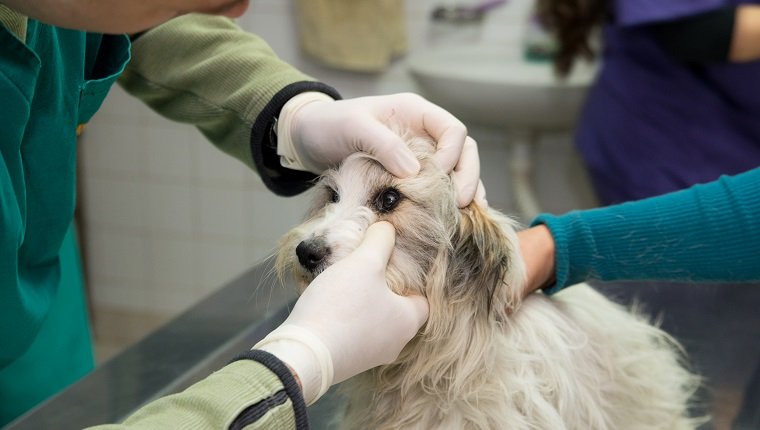Pink eye in dogs, also known as “red eye” or conjunctivitis, is an itchy inflammation of the tissue in the inner eyelids and the whites of the eyes. Treatment of conjunctivitis is important because the condition can result in pain, blindness, and further infection in canines if left untreated.
Conjunctivitis in dogs may look the same as pink eye in humans, but it is often caused by irritation from a foreign substance or allergen, rather than a contagious infection. In some cases, however, it can result from infection, or it could accompany other conditions.
It is important to consult your veterinarian to determine the cause of conjunctivitis in your dog and treat it accordingly. Here’s what you should know about the causes, symptoms, and treatments for pink eye in dogs.
Causes Of Pink Eye In Dogs

Pink eye can be caused by anything that results in inflammation to the conjunctiva, or the tissue of the eyelids and white parts of the eyes. There are many irritants, infections, and conditions that can lead to this inflammation.
Here are a few common causes of pink eye in dogs:
- Irritants in the air such as smoke, dust, or perfume
- Foreign object lodged in the eye or under the eyelid
- Immune disease
- Canine distemper
- Upper respiratory tract infection
- Infections from bacteria such as streptococcus and staphylococcus
- Viral infections
- Glaucoma
- Dry eye or inability to produce enough tears
- Obstructed tear ducts
- Malformed eyelids
- Eye injury
- Allergies
Rarely, pink eye can be caused by the presence of cancerous tumors. Sometimes it can also result from lesions that appear as pink masses, which are not cancer, but appear most commonly in Collies.
German Shepherd Dogs are also predisposed to a certain type of pink eye called plasma-cell conjunctivitis.
Symptoms Of Pink Eye In Dogs

The symptom of pink eye that is most noticeable is the pink or red hue found in the whites of the eyes. However, there are several other signs of conjunctivitis that you should look out for.
Other symptoms may include the following:
- Puffy eyelids
- Watery, mucus, or pus discharge
- Squinting
- Frequent spasms of blinking
- Swelling of the eyes
- Pawing at the eyes or rubbing against the ground or furniture
- Eyelids stuck shut
- Sneezing or coughing
Treatment Of Pink Eye In Dogs

Because conjunctivitis in dogs is usually the result of an irritant and not a contagious infection that can spread from dog to dog, treatment will most of the time involve flushing the eyes and reducing inflammation with eye drops and ointments. If the irritant is an allergen, this may be followed up with antihistamines.
In the case of a bacterial infection, the vet may prescribe antibiotics such as oxytetracycline, tobramycin, or ciprofloxacin. These can come in eye drops, ointments, or pills, and your dog may be prescribed several drugs at the same time to cover multiple bacteria.
Usually once the infection is gone, it will not return unless your dog continues to interact with contaminants.
If conjunctivitis results from an underlying condition, that condition will have to be treated separately. Immune disease, distemper, and upper respiratory tract infection all have their own prescribed treatments. Certain types of tumors or deformities of the eyelids or eyes may require surgery.
Prevention of pink eye is possible by reducing interactions with contaminated water or other materials. Eliminating exposure to known allergens or irritants, such as cigarette smoke, also helps. Staying up-to-date on vaccinations for conditions such as distemper will further reduce the risk of contracting pink eye as a secondary condition.
Has your dog ever had pink eye? How did you treat it? Let us know in the comments below!









